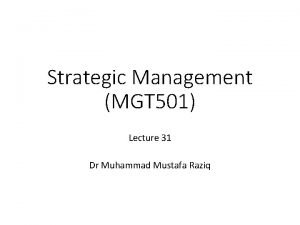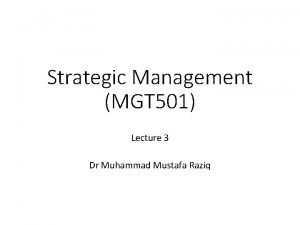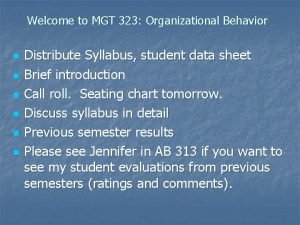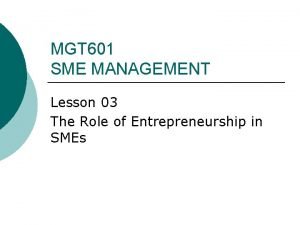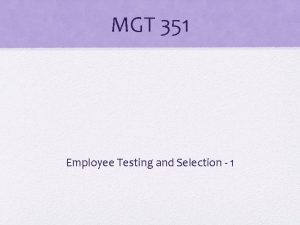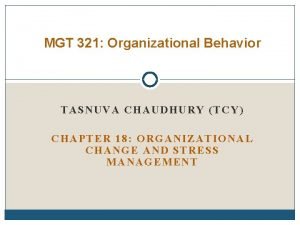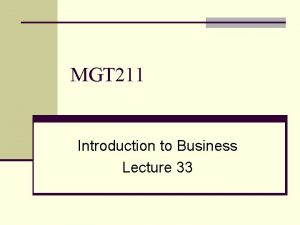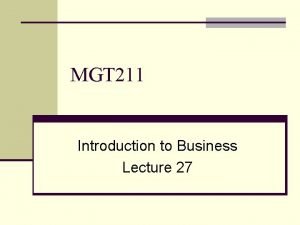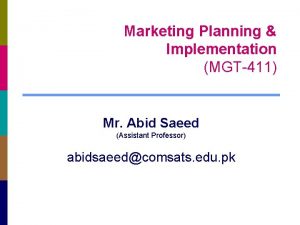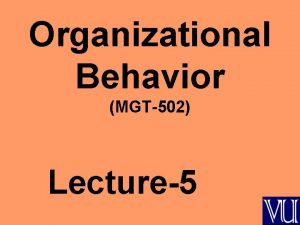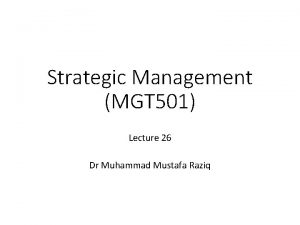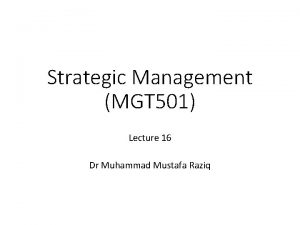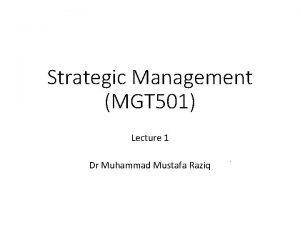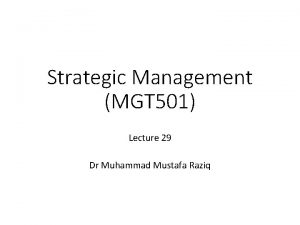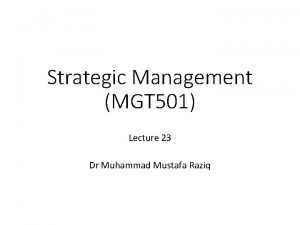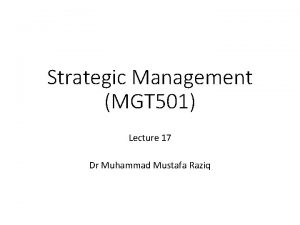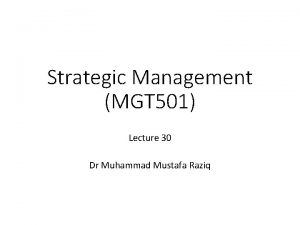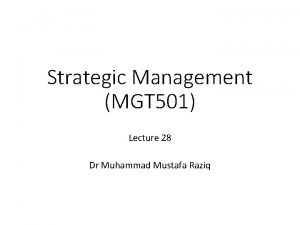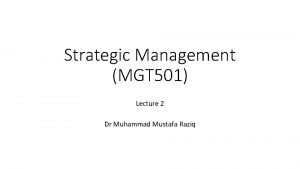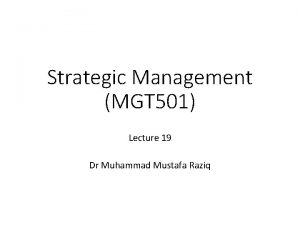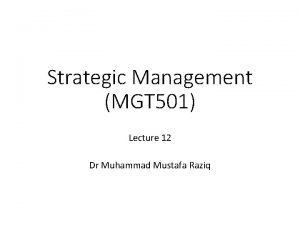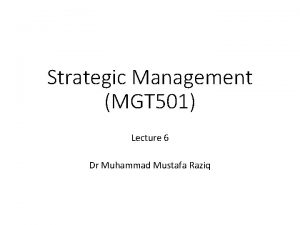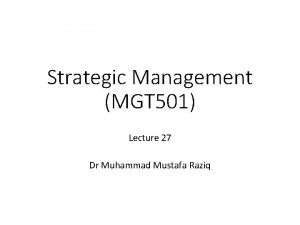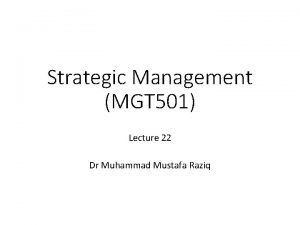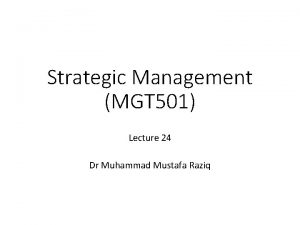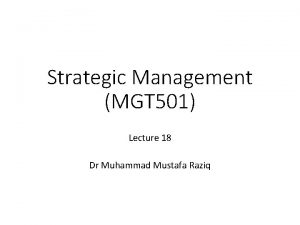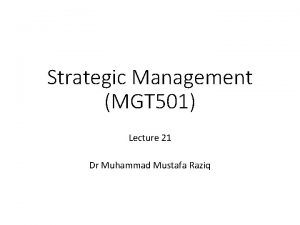Strategic Management MGT 501 Lecture 31 Dr Muhammad




















- Slides: 20

Strategic Management (MGT 501) Lecture 31 Dr Muhammad Mustafa Raziq

Topic Covered in the Previous Lecture • Decision Making During Strategy Execution • Structural Implementation • Functional Implementation

Topics to be covered in this lecture • Procedural implementation • Resource allocation • Strategic initiatives • Strategic repositioning • Innovation and entrepreneurship • Business process re-engineering

9. 7. Procedural Implementation • To start a business (e. g. a retail shop, manufacturing plant etc. ), there are elaborate set of procedures set by industry-specific laws, general laws, local laws, rules, and procedures. • Government creates and changes the external business environment in many ways through its procedures for approvals, sanctions, permissions, and statutory benefits. • Whatever the firm strategy be, it can be implemented only within the procedural limits of the regulations and rules operating in each context.

9. 8. Resource Allocation • Resources follow the strategy by decisions on how much to invest, where to invest, when to invest, and which areas of business that are linked to strategic objectives. • Budgeting based on annual objectives chosen from the strategy is the usual method followed for resource allocation.

9. 8. 1. Budgets • Budgets are an important implementation tool to control costs, coordinating activities, and establishing responsibilities. • Budgeting process starts with identifying the objectives and communicating them to the budget preparation team. • Sales forecast or product demand is the key element based on which resource allocation for procurements, hiring personnel, operations, and marketing are done in the operating budget. • Capital budget follows usually product portfolio approach, demands of the strategic direction of the firm, and influences from different divisions of resources.

9. 8. 2. Resource Mobilization and Resources for Implementing Strategy • To achieve the strategic objectives resources are mobilized and allocated strategically. • Resources to implement strategy may be as follows: Finances, Technology, HR, Knowledge, Information, Alliances, Organizational culture and identity, Leadership, Brand equity etc. • Resources are to be mobilized (organized), for example, human resources of the firm are to understand internalize the strategy and its components to carry out the activities listed in the action plan on time. Therefore human resources are to be mobilized similar to mobilizing an army to battle.

9. 8. 3. Initial Public Offering and Venture Capital • IPO is the first sale of shares by a private firm to the public – it is done by younger companies to expand, and larger firms to diversify. • An underwriting firm (an investment bank) helps the firm to decide the time to bring the shares to market, best offer price, and type of securities to issue. • Venture capital is the type of financing provided to early stage companies for start-up funding or to mature companies to bring new products to market. • VC firms assist in governance and providing expertise such as marketing, arranging supplies, debt financing, etc.

9. 9. Strategic Initiatives • A strategic initiative responds to a critical organizational performance issue or a business problem resulting in a significant impact on the firm’s results. Performance issues may be because of the following: • Absence of a befitting strategy; internal weaknesses; external pressures; not updating with the technology timely; not recognizing accurately the sources of growth and decline; bad governance; flawed leadership; and, operational inefficiency. • Strategic initiatives are adopted in accordance with the firm’s vision to address these issues hoping that the initiative would transform the firm leading to superior performance.

9. 9. 1. Success factors of strategic initiatives • For strategic initiatives to succeed, whether in a new organization, in a growing organization, or in a declining organization, there a few significant factors: • Availability of previous experience to the leadership in strategic management • Creating a open climate among both internal and external stakeholders • Having a shared vision and a compelling mission known to all • Actionable programs with goal oriented metrics • Alignment of objectives of all stakeholders and early resolution of conflicts • Coherence of the 7 S (e. g. strategy, structure, system, shared values etc) of the organization and managerial stamina in the firm

9. 10. Strategic Repositioning • Strategic repositioning is a firm’s intention to move to a more favorable position and/or to surrender previous position in a strategic space • It is to change the way in which the firm’s offerings are conceived in the market place. Positioning is the deliberate, proactive, interactive process of defining, modifying, and monitoring consumer perceptions of a marketable object (Arnott, 1992) • Positioning is the firm’s unique way of delivering value to customers i. e. the firm’s value positioning • Strategic repositioning is a fundamental shift in the firm’s value proposition by seeking to change its market segments and/or its basis of differential advantage (Turner, 2003)

9. 11. Innovation and Entrepreneurship • Entrepreneurship in established firms allow people to be innovative, creative, and responsible for decisions that they make (Meyer and Heppard, 2000). • Entrepreneurial initiatives and opportunities are leveraged deliberately for growth and advantageseeking purpose • An entrepreneurial strategy should be an important element of the corporate strategy • In such a situation or strategic context, individuals are motivated to be innovative and such innovations are captured as part of the long-term growth process of the firm.

9. 11. 1. Sources of Innovation • Dynamism and firm-wide innovative capability leads to individual level outcomes and financial, behavioral, and organizational level outcomes. • The organizational processes, administrative mechanisms, organizational boundaries, work discretion or autonomy, and reward or reinforcement systems promote and sustain entrepreneurial initiatives in a firm resulting in significant improvement in the firm performance. • Creativity and innovation in the context of entrepreneurship is a convergence of three components: knowledge (expertise), creative thinking (imagination), and motivation (intrinsic passion and interest in work) (Amabile, 1992)

9. 11. 2. Entrepreneurship Strategy • Human behavior is defined as entrepreneurial when oriented towards opportunities (Shane and Venkataraman, 2000). • Opportunity is regarded as a potential to create value. The value may be economic value in the form of growth in sales volume or growth in profits, or social value for the society in the form of innovative solutions to society’s pressing issues, or ecological value in the form of regeneration of natural systems and use of eco-friendly processes. • Unlike the traditional strategic management process, strategic management for entrepreneurship is exploratory with frequent changes in direction. • Frequent reviewing of the business plans based on feedback from the market place leads to refinement of the strategy. • Social enterprises create ‘blended value’ by working both for social and for financial gain (Chell, 2007)

9. 11. 3. Corporate Entrepreneurship Strategy • Corporate entrepreneurship strategy refers to value creation by carrying out new combinations, self renewal, creation of new business ventures, other innovative activities, orientations, and proactiveness within an existing organization. • A redefinition of the business model, reorganization, introduction of system-wide changes for innovation, and initiative in pursuing new opportunities or entry to new markets are corporate entrepreneurship behaviors.

9. 12. Business Process Reengineering • It is the analysis and redesign of the workflow within and between enterprises in order to optimize end-to-end processes and automate nonvalue added tasks. • Many companies implemented BPR in the 1990 s with success achieved through downsizing, reducing response time, cut operational costs, and improving profits.

9. 12. 1. Business Process Analysis • A business process is a set of logically related tasks performed to achieve a defined business outcome (Davenport, 1990) • They are interrelated activities creating value added output to a customer. • Business processes are analyzed with objectives such as speed or time to market, improve cost structure, improve quality, improve productivity, satisfaction of customer needs at less cost, and enhance competitiveness. • Firms should analyse their processes to check whether they add value and whethere is scope for reducing the consumption of resources required for delivering the products or services (Hammer, 1990).

9. 12. 2. Re-engineering or Redesigning • Re-engineering is a customer focused and outcome oriented strategic initiative in firms directed at achieving organizational mission. The processes that are in greatest need of improvement in terms of cost, quality, and timelines are identified, and through benchmarking, new processes are identified. • Re-engineering strives to sharpen the following attributes of processes: • Process ownership • Customer focus • Value addition • Cross functionality

Summary of the topics covered in this lecture • Procedural implementation • Resource allocation • Strategic initiatives • Strategic repositioning • Innovation and entrepreneurship • Business process re-engineering

Topics for the next lecture • Corporate Governance • Strategic Leadership • Monitoring Strategy Implementation
 Mgt 501
Mgt 501 Mgt 501
Mgt 501 Mgt501 human resource management
Mgt501 human resource management Ilayka anta sabahi
Ilayka anta sabahi Atahiyatu
Atahiyatu Strategic management lecture
Strategic management lecture Strategic competitiveness
Strategic competitiveness Tows matrix
Tows matrix 01:640:244 lecture notes - lecture 15: plat, idah, farad
01:640:244 lecture notes - lecture 15: plat, idah, farad Mgt 323
Mgt 323 Define management accounting
Define management accounting Mgt 601
Mgt 601 Mgt 351 nsu course outline
Mgt 351 nsu course outline Assignment mgt340
Assignment mgt340 Mgt321
Mgt321 Mgt 211
Mgt 211 Luyana211
Luyana211 Mgt 411
Mgt 411 Mgt 385
Mgt 385 Ecv expected commercial value
Ecv expected commercial value Mgt502 business communication
Mgt502 business communication
